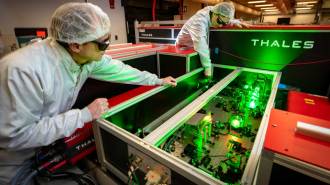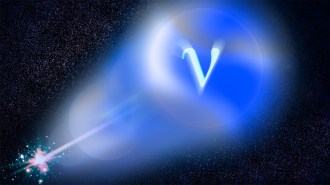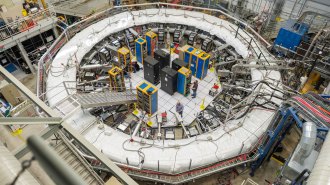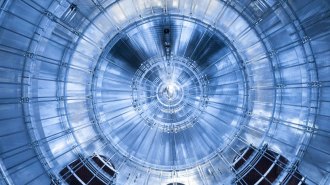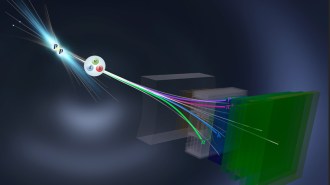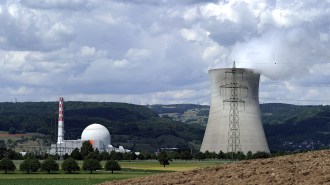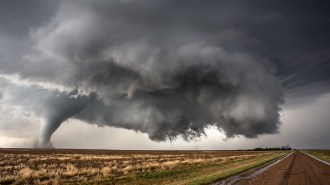A primordial black hole may have spewed the highest energy neutrino ever found
These theoretical black holes may have formed right after the Big Bang
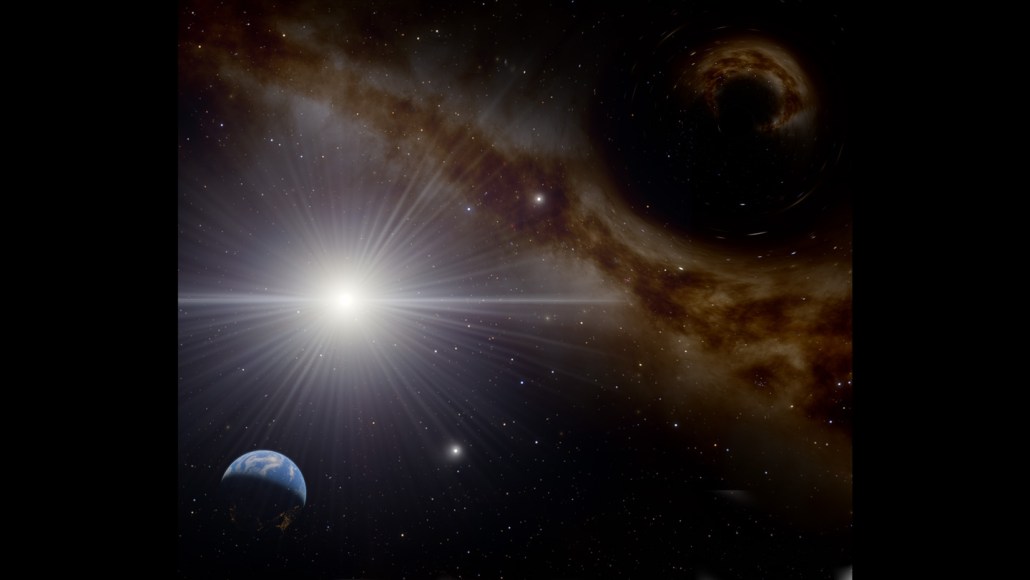
A primordial black hole (illustrated, top right) near the solar system may have exploded with particles at the end of its life, including the highest energy neutrino (left) ever detected to reach Earth.
Toby Gleason-Kaiser, using SpaceEngine @ Cosmographic Software LLC
The highest energy neutrino ever detected from space may finally have an origin story.
Mathematical analyses suggest that the ghost particle could’ve come from a theoretical object known as a primordial black hole, researchers report September 18 in Physical Review Letters. Thought to have emerged right after the Big Bang, primordial black holes could reveal the origin of super energetic neutrinos and answer long-standing queries about black holes and dark matter.
“This is not proof, but it’s incredibly exciting, I think, to see these multiple puzzles being susceptible to one fairly straightforward possible answer,” says MIT physicist David Kaiser.
Neutrinos are lightweight, electrically neutral particles that zip through space without interacting much with ordinary, observable matter. Most that reach Earth have low energies and come from common reactions, like nuclear fusion in the sun, Kaiser says.
But in February 2023, an underwater neutrino detector near Sicily picked up signals linked to a neutrino with an estimated energy of 220 million billion electron volts, about 35 times as energetic as the past record holder. Researchers don’t know what produced it or the five other highest energy neutrinos.
Kaiser and MIT physicist Alexandra Klipfel wondered if explosions of primordial black holes could have blasted the high energy particles toward Earth. These theoretical objects might be the main component of dark matter, the mysterious stuff that accounts for about 85 percent of the universe’s matter.
Physicist Stephen Hawking proposed some 50 years ago that black holes leak energy, causing them to lose mass, grow hotter and emit increasingly higher energy particles until they explode. Some primordial black holes might be bursting today, 13.8 billion years after their births. Each would contain the mass of a moose packed down smaller than a proton, Klipfel says.
She and Kaiser first calculated how many high energy neutrinos an explosion would release. That number factored into an analysis considering the estimated initial distribution of primordial black holes, their shrinkage over time, the distribution of dark matter and the six most energetic ghost particles detected on Earth. The calculations suggested that about 40 explosions per cubic light-year happen annually near the solar system.
Given the small proportion of neutrinos with the record holder’s energy produced by each event, the team found that one bursting black hole could have been close enough to Earth within the past 14 years to spit out such an energetic neutrino that lands on a detector. These super energetic neutrinos disperse in all directions, growing farther apart as they travel. So the closer the source is to the planet, the more likely an ultrahigh energy neutrino is to interact with a detector, Klipfel says.
“Only a small fraction [of neutrinos from an explosion] would ever happen to be heading toward the Earth,” Kaiser says, and “a small fraction of those would really hit a detector.”
He notes that if future research finds that most high energy neutrinos come from the center of the Milky Way, that could hint at a link to primordial black holes.
A concentration of such neutrinos near the galactic center would be consistent with the idea that primordial black holes are both a source of the neutrinos and a candidate for dark matter, which is thought to cluster around galaxy cores — though not definitive proof. Such evidence would also help validate Hawking’s leaky black hole theory.
Dozens of studies have tried to identify the source of the record-smashing neutrino, says physicist Luigi Fusco of the University of Salerno in Fisciano, Italy, who is part of the team that detected it. A primordial black hole is an intriguing, more exotic proposition, he says, though it’s too soon to declare it the origin.
But physicist Lua Airoldi doubts the idea, since a nearby explosion should’ve spewed other particles, like gamma rays, which weren’t detected. “Not seeing gamma rays would be like standing outside during a tropical storm and only feeling a single raindrop hit you,” says Airoldi, of the University of São Paulo. She and her colleagues submitted their work pushing back on the proposition May 30 to arXiv.org.
Kaiser contends that the opposing paper’s calculations are based on different assumptions. His and Klipfel’s work, he says, suggests the exploding object would have been too far from Earth — around 50 times the distance Pluto is from the sun — for its gamma rays to be observed.
Still, “even the [highest energy neutrino] event itself is under debate,” says Penn State physicist Kohta Murase, who wasn’t involved in the new work. Some researchers aren’t convinced by the neutrino’s energy estimate because the detector was still under construction. Many more steps must be taken to find the origins of ultraenergetic ghost particles, he says.
